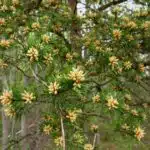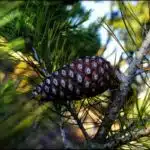Scots Pine tree, scientifically known as Pinus sylvestris, is a widely grown species in the Northern Hemisphere. It is a hardy evergreen coniferous tree that can survive in a variety of soil types and climatic conditions. In addition to its aesthetic value, Scots Pine is also valued for its commercial use in timber production, making it an economically important tree species. This article will provide guidance on how to grow and care for this resilient and valuable tree.
When growing Scots Pine trees, it is essential to consider factors such as planting location, soil type, watering needs, and fertilization requirements. Proper care during the early stages of growth is critical to ensure healthy establishment and growth of the plant. Additionally, regular maintenance practices such as pruning and pest control are necessary to promote optimal health and longevity of the tree. This article will provide detailed information on each aspect of growing and caring for Scots Pine trees, enabling readers to cultivate healthy trees that add beauty and value to their surroundings.
Planting Location: Choosing The Right Spot
Imagine standing in a vast, open field, gazing at a scots pine tree that towers above you. The beauty of its long, slender needles and sturdy branches that stretch towards the sky is breathtaking. If you’re considering planting a scots pine tree in your garden, it’s important to choose the right planting location.
Sunlight exposure is vital when selecting a suitable spot for your scots pine tree. These trees require ample sunlight to thrive, so it’s essential to select an area that receives full sun exposure for most of the day. This will ensure that your tree grows tall and strong with a dense canopy of needles.
Aside from sunlight exposure, wind protection is another crucial factor to consider when planting scots pines. Due to their height and narrow shape, they are susceptible to damage from strong winds. Therefore, it would be best if you chose a location where other trees or buildings can provide wind protection. This will help prevent breakage of limbs and ensure healthy growth over time.
As horticulturalists or arborists know all too well, choosing the right spot for your scots pine tree is critical in ensuring its success in growth and longevity. With proper sunlight exposure and wind protection provided by nearby structures or trees, your scots pine will flourish beautifully for many years to come. In the subsequent section about soil type: what scots pine trees prefer we explore further essential factors for optimal growth of this majestic tree species.
Soil Type: What Scots Pine Trees Prefer
Soil pH is an important factor for Scots Pine trees, as they prefer acidic soils with a pH of 4.5-6.5. Soil drainage is also important to consider, as the tree requires well-draining soil in order to avoid standing water. Although Scots Pine trees are able to tolerate a wide range of soil types, they grow best in sandy soils with good aeration. To ensure optimal growth, it is recommended that a soil test is performed to determine the soil pH and drainage of the planting site.
Soil Ph
When it comes to growing and caring for Scots pine trees, the type of soil you use is crucial. Scots pines prefer well-drained soils that are slightly acidic in nature. However, not all soils come with ideal pH levels for these trees. Therefore, testing your soil and adjusting its pH level can go a long way in ensuring that your Scots pine tree thrives.
Testing your soil is the first step in determining whether it has the right pH level for Scots pine trees. You can use a soil testing kit to determine the pH level of your soil accurately. Once you’ve established the pH levels, you’ll know how much adjustment is necessary to ensure that it falls within the optimal range for Scots pines.
Adjusting pH levels may be necessary if your soil is too alkaline or too acidic for Scots pine trees. If your soil is too alkaline, you can add elemental sulfur to lower the pH levels gradually. On the other hand, if your soil is too acidic, adding dolomite limestone can help raise its pH levels gradually. It’s essential to follow recommended application rates when adjusting pH levels since overdoing it can have adverse effects on tree growth.
In conclusion, maintaining optimal soil conditions for Scots pine trees involves adjusting pH levels where necessary. Always test your soil before planting any tree and adjust its nutrient composition accordingly. With proper care and attention, your Scots pine tree will thrive and provide aesthetic value while contributing to environmental health.
Soil Drainage
Soil drainage is another essential factor to consider when growing Scots pine trees. These trees require well-drained soils that don’t retain too much water, which can result in root rot and other fungal diseases. Therefore, improving soil drainage is crucial for the health and growth of Scots pine trees.
One way to improve soil drainage is by adding organic matter such as compost or leaf mulch. These materials increase the soil’s ability to hold water while also allowing excess water to drain away quickly. Another method is installing a French drain or a gravel bed around the tree’s roots to prevent erosion and improve drainage further.
Preventing erosion is also critical when it comes to maintaining optimal soil conditions for your Scots pine tree. Erosion can lead to nutrient loss, compaction, and even death of the tree. To prevent erosion, you can install retaining walls or terraces on sloping ground around the tree’s base. Additionally, planting ground cover plants such as grasses or low-growing shrubs can help stabilize slopes and prevent erosion.
In conclusion, improving soil drainage by adding organic matter and preventing erosion through installing retaining walls or planting ground covers are crucial steps in ensuring that your Scots pine tree thrives. By taking these measures, you’re creating optimal soil conditions for your tree’s growth while also contributing to environmental health.
Watering Needs: How Often To Water
Scots pine trees prefer well-drained soil with a slightly acidic pH level ranging from 4.5 to 6.5. They can tolerate various soil types, including sandy, loamy, and clay soils. However, they do not grow well in waterlogged or compacted soils. The ideal soil type for growing and caring for Scots pine trees is sandy loam, which is a mixture of sand, silt, and clay.
Maintaining appropriate soil moisture levels is crucial for the healthy growth of your Scots pine tree. These trees require regular watering during their first year after planting to establish root systems. After the establishment period, Scots pine trees can tolerate drought conditions but perform better when adequately irrigated. Watering frequency depends on several factors such as weather conditions, soil type, tree age, and size. In general, it is recommended to water young trees every two weeks during dry seasons and mature ones every month.
It is essential to avoid overwatering your Scots pine tree as it can lead to root rot and other fungal diseases that can cause severe damage or even death of your tree. You can check the soil moisture level by inserting a garden trowel about six inches into the ground near the roots’ base. If the soil feels moist at this depth, you may skip watering until it dries out partially before watering again. In contrast, if the soil feels dry at this depth, you should water your tree immediately to prevent wilting or stress caused by insufficient water supply.
Fertilization Requirements: Nourishing Your Tree
As a horticulturalist, the nourishment of your Scots pine tree is crucial to its growth and overall health. Fertilizers provide essential nutrients that contribute to the development of strong roots, branches, and needles. When it comes to fertilization, you have two options: organic or chemical fertilizers. Organic fertilizers contain natural elements such as manure or compost and are an excellent choice for those seeking an environmentally friendly option. Chemical fertilizers, on the other hand, are synthetically produced and can deliver faster results but may have negative impacts on soil health.
Timing is essential when it comes to fertilization. It’s recommended to apply fertilizer during the growing season (spring-summer) to help your tree grow faster and healthier. However, avoid fertilizing during periods of drought or excessive heat as this could lead to root burn or damage the tree further. For young trees, start with a low dose of fertilizer and gradually increase over time until you reach the recommended dosage.
In conclusion, keeping your Scots pine tree healthy through proper nourishment is critical in maintaining its beauty and longevity. Choose between organic or chemical fertilizers based on your preference and timing is key when applying them for optimal growth. The next step in caring for your Scots pine tree involves seed selection: choosing the right seeds that will produce a healthy and thriving tree in your garden or landscape.
Seed Selection: Choosing The Right Seeds
After fertilizing your Scots pine tree, it’s important to choose viable seeds for planting. When selecting seeds, look for those that are fully matured and have a firm shell without any signs of damage or disease. Choose seeds from healthy parent trees that have exhibited desirable traits such as good growth rate, straight trunks, and dense foliage.
Once you have selected your seeds, it’s important to store them properly. Place the seeds in a sealed container such as a plastic bag or jar with a lid. Store the container in a cool, dry place such as a refrigerator, but keep them away from fruits and vegetables which release ethylene gas that can harm the viability of the seeds. Keep in mind that Scots pine seeds are only viable for about 2-3 years so it’s best to use them sooner rather than later.
When you’re ready to start germinating your Scots pine tree seeds, there are several methods you can use including stratification and scarification. Stratification involves placing the seeds in moist sand or peat moss and storing them in a cool place for several weeks before planting. Scarification involves nicking or scratching the seed coat to help water more easily penetrate into the seed allowing it to germinate faster. By properly selecting and storing your Scots pine tree seeds, you can ensure successful germination and begin growing healthy trees in no time.
Transition: With viable Scots pine tree seeds selected and stored correctly, it’s time to move onto germination: starting your seeds.
Germination: Starting Your Seeds
Seed selection is an important step in growing a healthy and thriving Scots pine tree. It is recommended to choose seeds from a reputable seed supplier, as this ensures that you are getting high-quality seeds that have been tested for viability. When selecting your seeds, look for those that are plump, firm, and uncracked. These characteristics indicate that the seed is healthy and has a good chance of germinating.
Once you have selected your seeds, it is important to store them properly until you are ready to plant them. Store your seeds in a cool, dry place with low humidity. This can be achieved by placing them in an airtight container or sealed plastic bag and storing them in the refrigerator or freezer. Avoid exposing your seeds to direct sunlight or moisture as this can cause them to deteriorate quickly.
When it comes time to plant your Scots pine seeds, there are several methods you can use for germination. One common method is to soak the seeds overnight before planting them in well-draining soil. Another method is to sow the seeds directly into the ground in early spring when temperatures begin to warm up. Regardless of which method you choose, make sure to keep the soil moist but not waterlogged during germination. With proper care and attention, your Scots pine seedlings will soon be ready for transplanting into their permanent location.
Transition: Now that we’ve covered how to start your Scots pine tree from seed, let’s move on to the next step: transplanting your seedlings into their new home.
Transplanting: Moving Your Seedlings
- Prior to transplanting, one should ensure that the roots of the seedling have been thoroughly soaked in water for at least 15 minutes for optimal absorption.
- When planting the seedling, the hole should be twice the diameter of the root ball and around the same depth.
- The root ball should be placed in the hole without allowing any of the roots to be exposed.
- After planting, a layer of mulch should be added and the area should be watered thoroughly.
Preparing The Seedling
Choosing the right container is crucial when preparing a Scots pine seedling for transplanting. It is recommended to use containers with drainage holes to prevent soil from becoming waterlogged and causing root rot. Containers that are too small may also impede the growth of the tree, while those that are too large can lead to overwatering and nutrient depletion. A container with a capacity of at least 10 inches in diameter and depth is ideal for Scots pine seedlings.
Once you have selected an appropriate container, it’s time to prepare the soil. Scots pines prefer well-draining soils with a pH range between 4.5-6.0. You can achieve this by mixing equal parts of peat moss, perlite, and sand into your potting mix. This mixture will provide adequate drainage while maintaining moisture levels suitable for healthy growth. Before planting your seedling, make sure to moisten the soil thoroughly but avoid soaking it.
After filling the container with soil, create a hole in the center big enough to fit the roots of your seedling comfortably. Gently remove your seedling from its previous container or nursery bed, being careful not to damage any roots in the process. Place your seedling into the hole and fill in any gaps with additional potting mix until it reaches ground level. Finally, water your newly transplanted Scots pine thoroughly but avoid overwatering as this can cause fungal diseases or root rot. With proper preparation and care, your Scots pine will thrive in its new home!
Planting The Seedling
Choosing the right container and preparing the soil are crucial steps when transplanting Scots pine seedlings. However, planting the seedling itself is just as important in ensuring its successful growth. When planting your seedling, it’s essential to consider factors such as light exposure and proper positioning.
Scots pines require full sun, so it’s important to plant them in an area that receives at least six hours of direct sunlight per day. If you’re growing your seedlings indoors, make sure to place them near a south-facing window or under grow lights that provide enough light for healthy growth. When planting your seedling, position it in the center of the container and ensure that the stem is straight and upright.
After planting your seedling, cover the soil around the base with a layer of organic mulch such as wood chips or bark. This will help retain moisture while suppressing weed growth and regulating soil temperature. Continue to water your seedling regularly but avoid overwatering as this can lead to root rot or fungal diseases. With proper care and attention, your Scots pine will thrive in its new home and provide years of beauty and enjoyment!
Early Care: Protecting Your Young Tree
As you stand in your yard, gazing down at the little sapling that is your Scots pine tree, you may be tempted to coddle it like a newborn baby. While it’s true that young trees require a bit of TLC, you don’t need to go overboard with it. Follow these early care tips to give your tree the best possible start in life.
Firstly, let’s talk about mulch. Applying a layer of organic material around the base of your tree can work wonders for its growth and health. Mulching benefits include retaining moisture in the soil, regulating soil temperature, and suppressing weed growth. When applying mulch, make sure not to pile it too high against the trunk as this can cause rotting.
Secondly, staking methods should be considered when planting your tree. Staking can help prevent wind damage and ensure that your young tree grows up straight and strong. However, be cautious not to over-stake as this can lead to weaker trunks later on. Generally speaking, a single stake placed at a 45-degree angle away from the trunk is sufficient for most trees.
Now that you’ve learned about mulching benefits and staking methods for protecting your young Scots pine tree, you’re well on your way to ensuring its long-term success. In the next section, we’ll discuss pruning: keeping your tree in shape. By following these simple steps and taking proper care of your young tree during its formative years, you’ll be rewarded with a beautiful and healthy addition to your landscape for years to come.
Pruning: Keeping Your Tree In Shape
Pruning techniques are crucial to maintaining a healthy and attractive Scots pine tree. When done properly, pruning can help remove diseased or dead branches, promote new growth, and maintain the desired shape of the tree. However, improper pruning can harm the tree and even lead to its death. Therefore, it is important to have a good understanding of pruning techniques before attempting to prune your Scots pine tree.
One of the most important aspects of pruning is maintaining shape. Scots pine trees have a naturally conical shape that should be preserved through proper pruning techniques. This involves removing any branches that grow too low on the trunk or too close to each other, as they can interfere with the overall shape of the tree. It is also important to avoid cutting off too much foliage at once, as this can cause stress to the tree and weaken its overall health.
When pruning your Scots pine tree, it is essential to use sharp tools that make clean cuts without tearing or damaging the bark. Before making any cuts, take a step back and assess the overall shape of the tree. Identify which branches need to be removed or trimmed in order to maintain its natural form. Always cut just outside of the branch collar (the swollen area where a branch attaches to the trunk) using an angled cut that slopes away from the trunk. This will help prevent damage and ensure proper healing for your tree.
- When should you prune?
- Late winter or early spring when trees are still dormant.
- What tools should you use?
- Pruning shears for small branches
- Lopping shears for larger branches
In summary, proper pruning techniques are essential for maintaining a healthy and attractive Scots pine tree. Maintaining its natural conical shape is key when shaping your tree while avoiding over-pruning is also necessary not only for your aesthetics preference but also for keeping it healthy . Using quality tools and making clean cuts is crucial to avoiding damage to the tree. In the next section, we will discuss pest control techniques for preventing and treating infestations in your Scots pine tree.
Pest Control: Preventing And Treating Infestations
As much as we’d like to keep our Scots pine trees healthy and thriving, they are not immune to pest infestations. These pests can cause significant damage to the tree’s foliage, bark, and even its roots if left untreated. The damage can vary depending on the type of pest that has infested your tree. However, common signs include yellowing or browning needles, wilting branches, and visible bug activity.
Fortunately, there are natural remedies that you can use to control these pesky pests without resorting to chemical treatments. One such method is to introduce beneficial insects into your garden. These insects prey on the pests and their larvae, keeping their populations in check. Another effective way is using organic insecticides made from natural ingredients such as essential oils or soap sprays.
If the infestation has already taken hold of your tree and is beyond natural remedies’ scope, then you may need to consider chemical treatments. Chemical treatments involve using pesticides that contain active ingredients that kill or repel the pests. However, it’s essential to follow the instructions carefully when using pesticides as they can be harmful if used incorrectly. Always use protective gear such as gloves and masks when applying pesticides.
Winter care: protecting your tree from the cold As winter sets in, it’s essential to protect your Scots pine tree from harsh weather conditions such as frost and snow damage. In this section, we’ll cover some essential steps you can take to ensure your tree emerges healthy in springtime.
Winter Care: Protecting Your Tree From The Cold
As temperatures begin to drop, it’s important to take steps to protect your Scots pine tree from the harsh winter weather. One effective way to do this is through winter mulching. Applying a layer of organic material, such as leaves or straw, around the base of the tree can help insulate its roots and retain moisture throughout the cold season. Be sure to spread the mulch evenly and avoid piling it up against the trunk, as this can create an environment for pests and disease.
Another essential aspect of winter care for Scots pine trees is frost protection. When temperatures reach freezing levels, water inside plant cells can freeze and cause damage or death to the tree. To prevent this, consider wrapping burlap or other breathable materials around the trunk and lower branches. This will act as a barrier against frost while still allowing air circulation. You may also want to cover young trees with a tarp or blanket during particularly cold nights.
By taking these measures for winter care, you can help ensure your Scots pine tree stays healthy and strong throughout the winter months. Remember to monitor your tree regularly during this time, checking for signs of stress or damage caused by weather conditions or pests. In our next section, we will discuss mature tree care and how to maintain health and beauty as your tree grows older.
Mature Tree Care: Maintaining Health And Beauty
As your Scots pine tree grows taller and sturdier, it will require a different set of care measures to ensure its optimal health and beauty. With proper maintenance, you can prevent diseases and other problems that might affect the tree’s overall growth. Here are some tips on how to maintain a healthy mature Scots pine tree:
Pruning: One of the most important things you can do for your mature Scots pine is to trim away any dead, damaged, or diseased branches. Regular pruning will help improve the air circulation around the tree, allowing it to grow stronger and healthier over time.
Fertilization: Mature trees require regular fertilization to maintain their health and vigor. You should apply a balanced fertilizer that contains equal parts nitrogen, phosphorus, and potassium once every two years in late fall or early spring.
Disease prevention: To prevent diseases from affecting your mature Scots pine tree, ensure there is good drainage around the base of the tree by avoiding overwatering it. Also, avoid using too much mulch around the base of the trunk as this may attract pests that could damage the bark.
Soil management: Mature Scots pine trees prefer well-drained soil with a pH between 5-7. You should regularly check for soil imbalances by conducting soil tests at least once every three years to determine if any adjustments are necessary.
Maintaining a healthy mature Scots pine tree requires ongoing care and attention to detail. By following these tips on pruning, fertilization, disease prevention, and soil management practices, you can keep your tree healthy and beautiful for years to come. In our next section about timber production: harvesting your trees we will explore how you can safely harvest timber from mature Scots Pine trees without damaging them in any way possible.
Timber Production: Harvesting Your Trees
Once your Scots pine trees have reached maturity, you can start thinking about harvesting them for timber production. However, it is important to ensure that you practice sustainable harvesting techniques to avoid damaging the environment and depleting resources.
Before harvesting, consider the market demand for your particular species of tree. Scots pine is a popular choice for construction lumber, pulpwood and furniture making due to its straight grain and durability. You can reach out to local forestry associations or timber buyers to get an idea of pricing and demand in your area. Harvesting at the right time and selling when prices are high can be beneficial financially.
Sustainable harvesting practices involve careful planning of each cut, ensuring that only select trees are removed while younger ones are left to grow. This will allow woodland ecosystems to remain intact while providing a long-term source of timber. Additionally, using low-impact machinery can help minimize damage to the forest floor and reduce soil erosion. By practicing sustainable harvesting techniques, you not only benefit from a reliable source of income but also contribute towards preserving our natural resources for future generations.
Transition: Now that we have discussed the importance of sustainable harvesting techniques let’s delve into how Scots pine trees provide environmental benefits beyond their use as a commercial resource in the subsequent section on ‘environmental benefits: how scots pine trees help the planet’.
Environmental Benefits: How Scots Pine Trees Help The Planet
- Scots Pine trees are a species of coniferous tree known for their multiple environmental benefits, including carbon sequestration, pollutant mitigation, and wildlife habitat.
- In terms of carbon sequestration, Scots Pine trees are a significant source of oxygen production and have the capacity to store large amounts of carbon within their woody biomass.
- In terms of pollutant mitigation, Scots Pine trees are effective in reducing air pollution, as they absorb and filter air pollutants such as ozone, nitrogen dioxide, and sulfur dioxide.
- Furthermore, Scots Pine trees provide valuable habitat for a range of wildlife, with the dense evergreen canopy providing shelter for small animals, and the seeds providing a food source for birds and squirrels.
- To maximize the environmental benefits of Scots Pine trees, proper care and maintenance is essential.
- This includes selecting the correct location for planting, pruning and trimming, and providing adequate irrigation during periods of drought.
Carbon Sequestration
Scots pine trees are known for their ability to sequester carbon dioxide from the atmosphere, making them an essential component of mitigating climate change. As a species that can live up to 700 years, Scots pine trees have the potential to store large amounts of carbon over their lifetime. This makes reforestation efforts critical in combating climate change, as it is estimated that forests can absorb up to 30% of human-caused carbon emissions.
Sustainable forestry practices play a crucial role in maintaining healthy Scots pine tree populations and maximizing their carbon sequestration potential. Practices such as thinning and selective harvesting allow for more space and resources for individual trees to grow and thrive, increasing their overall capacity for carbon storage. Additionally, sustainable forestry ensures that trees are harvested at a rate that allows for natural regeneration and continued growth, preserving both the ecological integrity of forests and their ability to sequester carbon.
The importance of reforestation cannot be overstated when it comes to mitigating climate change through carbon sequestration. By planting new Scots pine trees in areas where they have been lost due to deforestation or other causes, we can increase the total amount of carbon dioxide that is absorbed by forests. This not only helps combat climate change but also contributes to the restoration of entire ecosystems, creating habitats for wildlife and helping preserve biodiversity.
Pollutant Mitigation
Scots pine trees are more than just carbon sequesters; they also have air purifying properties. Indoor cultivation of Scots pine trees has been gaining popularity due to their ability to remove pollutants from the air, making them a valuable addition to any indoor space. In fact, studies have shown that indoor cultivation of Scots pine trees can significantly improve indoor air quality, reducing the levels of harmful pollutants such as formaldehyde and benzene.
The air purifying properties of Scots pine trees make them an effective tool in mitigating the negative effects of pollution on human health. Polluted air is linked to several respiratory and cardiovascular diseases, making it crucial to find ways to improve air quality indoors where people spend most of their time. By incorporating Scots pine trees into indoor spaces, we can reduce exposure to harmful pollutants, ultimately improving overall health and well-being.
Incorporating sustainable forestry practices into the cultivation of Scots pine trees can also contribute to pollutant mitigation efforts. By maintaining healthy tree populations through thinning and selective harvesting, we can ensure that these trees continue to thrive and provide their air purifying benefits for generations to come. Sustainable forestry practices not only benefit the environment but also contribute to creating healthier living environments for humans by reducing exposure to harmful pollutants in the air.
Wildlife Habitats
Scots pine trees offer a wide range of environmental benefits, including air purification and carbon sequestration. Another significant advantage of these trees is their role in providing wildlife habitats. Scots pine forests provide shelter and food for a variety of species, making them an essential part of ecological restoration efforts.
Wildlife observation is also another benefit that Scots pine forests offer. These forests create natural environments where people can observe and connect with wildlife. Wildlife observation promotes understanding and appreciation for nature, which can inspire individuals to take action towards environmental conservation.
Incorporating sustainable forestry practices into the cultivation of Scots pine trees can help ensure that they continue to provide vital wildlife habitats for generations to come. Maintaining healthy tree populations through thinning and selective harvesting creates diverse ecosystems that support a variety of species. By prioritizing the conservation of these forests, we can continue to reap the benefits they offer while also preserving them as valuable resources for future generations.
Conclusion: Growing And Caring For Your Scots Pine Tree
Scots pine trees are a great addition to any garden or landscape, not only for their aesthetic appeal but also for their environmental benefits. However, growing and caring for this species requires some knowledge and effort. Proper tree trimming is essential in maintaining the tree’s shape and structure, as well as its health.
When pruning your Scots pine tree, it is important to remove any dead or diseased branches promptly. This helps prevent the spread of disease and promotes new growth. It is recommended to trim during the dormant season, usually in late winter or early spring, when the tree is less susceptible to damage. Always use sharp and clean tools to prevent further injury to the tree.
Preventing diseases in your Scots pine tree starts with proper care and maintenance. Make sure that the soil is well-drained and not too wet, as waterlogged roots can lead to fungal infections. Avoid planting too close together, which can lead to overcrowding and increased risk of disease transmission. Regularly inspect your tree for signs of infection such as wilting leaves or discoloration and take immediate action if necessary.
Overall, growing and caring for a Scots pine tree requires attention to detail and timely maintenance. By following these simple tips on proper pruning techniques and disease prevention measures, you can ensure that your pine tree thrives for years to come.
Conclusion
Scots Pine trees are a beautiful addition to any landscape, and with the right care, they can thrive for many years. When planting your tree, make sure to choose a location that receives full sun and has well-draining soil. Water your tree deeply once a week during its first year, and then reduce watering to only during dry periods. Fertilize your tree annually in the spring to keep it healthy and strong.
When selecting seeds for planting, look for those that are from disease-resistant trees and have good growth characteristics. Once your tree is mature, continue to monitor its health and prune it as needed to maintain its shape and encourage new growth. Scots Pine trees also have benefits beyond their beauty, including providing habitat for wildlife and helping to reduce air pollution.
Overall, growing and caring for a Scots Pine tree requires patience and diligence but can be highly rewarding. With proper care, your tree will provide beauty, shade, and environmental benefits for generations to come. So why not add a Scots Pine tree to your landscape today? It’s an investment that will pay off in countless ways!
Image Credits
- “Jean and Bob with a Scots Pine tree” by bob the lomond (featured)





























